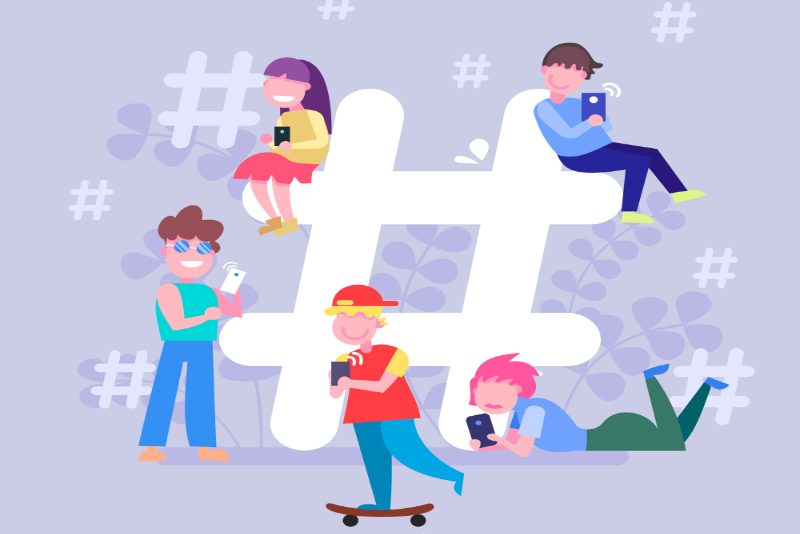No matter what anyone has to say, if you’re not convinced of the importance of hashtags, this read is for you! Hashtags are definitely an asset when it comes to your social media marketing strategy.
Hashtags have become a popular way to categorise and search for content on social media platforms, allowing businesses to increase their visibility and reach a wider audience. They affect the overall impact of your post and online social media presence.
Hashtags are a social media feature that can be tricky but trust us, once you get a hang of them you start seeing results almost immediately. Before we get into the how, let’s briefly discuss what are hashtags and why you need them.
Contents
What is a hashtag?
A hashtag is a word or phrase preceded by the “#” symbol used on various social media platforms to categorise content and make it easily searchable. Not just to posts but you can even add them to profile bios and comments.
Hashtags are commonly used on platforms like Twitter, Instagram, Facebook and LinkedIn to join in conversations, promote specific topics or events, or simply to make it easier for people to find your content.
You can participate in conversations and trends easily by using the right hashtags. For example, if you post something like this “#DidYouKnow the # made its debut on Twitter in 2007 by a product designer named Chris Messina” on Facebook, anyone who has searched for the hashtag #DidYouKnow will see this post.
- Since Hashtags operate as search filters, it’s important to use hashtags well to reach the right audience.
- You can connect with people and join various conversations.
- Hashtags are a great way to increase traffic and boost likes, visits and shares.
- Hashtags help you increase brand awareness.
- Hashtags can help you track the performance of your posts and social media strategy.
- Hashtags can help you create a sense of community and connect with your audience.
Recommended Reading: The unseen ROI of branding
Hashtags aren’t new in the digital marketing world. There may be some of us who are using hashtags but aren’t getting the expected results. Let’s go through some of the reasons they may be delivering great results:
- You may be using irrelevant hashtags or not niche specific hashtags.
- You may be using overused hashtags or not using hashtags consistently.
- You’re using too many hashtags.
- You’re not monitoring your hashtags’ performance and making changes to your strategy.
The first rule of using hashtags effectively is to use relevant ones. Hashtags should be related to the content you are posting. If you are posting a photo of a cat, for example, use #cat or #catsofinstagram. Using irrelevant hashtags can confuse your audience and hurt your engagement.
You must do research and can use apps such as Hashtagify and RiteTag to optimise your hashtag strategy.
Tip: Create a bank of hashtags you can use for different content buckets aligned with your brand in advance.
Trending hashtags are popular hashtags that many people are using at the moment. Using trending hashtags can help your posts reach a wider audience increasing your engagement. For example, the #IceBucketChallenge by ALS Association went viral on social media in 2014, raising awareness and funds for ALS research.
It raised awareness as well as resulted in ground-breaking engagement.
To find trending hashtags, you can use tools like Tagsfinder, Mention, Twitter Trends, Google Trends, or Hashtagify.
Industry-specific hashtags are hashtags that are related to your industry or niche. Using these hashtags can help you reach your target audience and connect with people who are interested in your content. On LinkedIn, you can explore related hashtags to your post by clicking on “Discover more hashtags”.
While hashtags can increase engagement, using too many of them can hurt your posts’ performance. Instagram allows up to 30 hashtags per post but studies show that using more than 10 hashtags per post can decrease engagement.
Recommended Reading: Ask These 10 Questions Before You Finalize Your Social Media Management Company
Branded hashtags are hashtags that are specific to your brand. They can be your brand name, slogan, or a unique phrase that represents your brand. Creating brand hashtags can help you create a community around your brand and encourage user-generated content.
For example, Coca-Cola uses the hashtag #ShareACoke to promote its personalised bottles.
You can also use hashtags in your social media bio to make it easier for people to find your content. Hashtags can also be used in Instagram and Facebook stories to improve visibility. When you add a hashtag to your story, it will be visible in the hashtag search results, and people who follow that hashtag will see your story.
You can add up to 10 hashtags to your Instagram stories.
Monitoring your hashtags can help you track your social media performance and identify opportunities for improvement. You can use social media monitoring tools like Hootsuite, Sprout Social, Keyhole, Inflact, or Mention to track your hashtags’ performance and see how people are engaging with your content.
8) Use a Hashtag generator
It’s important to leverage all your assets to increase your social media following and boost visibility. Using AI-powered tools such as Bundlepost, Leetags, Toolzu, or Inflact helps you generate as well as discover hashtags that are the right fit for your brand and post.
If you’re not already using hashtags, it’s time to start! By using relevant, balanced, and niche-specific hashtags, you can improve your engagement, visibility and reach on social media. Don’t forget to monitor your hashtags’ performance and adjust your strategy accordingly to ensure you’re getting the most out of your hashtags.
If this is something that excites you, also have a look at Toolcano where we bring you a repository of great tools you can use to optimise not just your hashtag strategy but your entire online presence!

